
Piercing the veil
A new exhibition at Buxton Contemporary finds a rich complexity in the shadowy terrain between life and death.
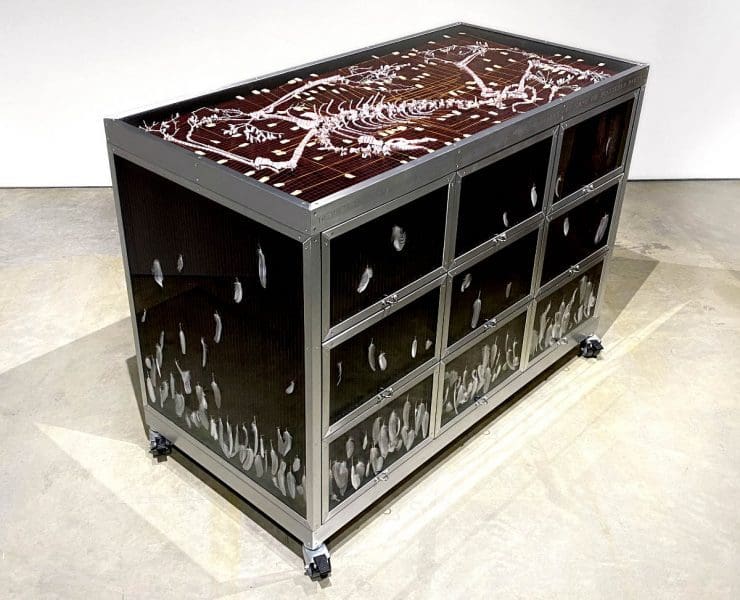
Patrick Hall, Forgotten Orders, 2021, collected bones, aluminium, plywood, glass, thread, feathers 87 x 60.5 x 102.5 cm.

Patrick Hall, On My Fathers Side, 2021, mirror, LED lighting, plywood, enamel paint 76 x 61 x 5 cm.
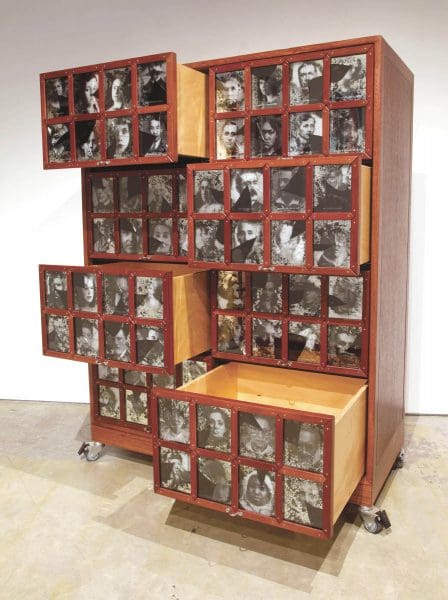
Patrick Hall, Made Of Broken Pieces Made Of Broken Pieces, 2021, plywood, glass, mirror, Tas oak 137.5 x 103 x 50 cm [open].

Patrick Hall, The Torn Whole, [detail], 2020, plywood, glass, graphite on drafting film, LEDs, electric motors 40 x 120 x 14 cm.
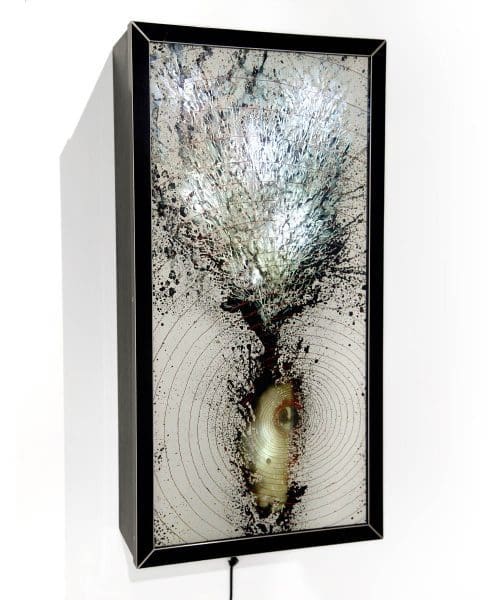
Patrick Hall, Boy, 2021, plywood, glass, mirror, LED lighting, enamel paint 60.5 x 30.5 x 12.5 cm.
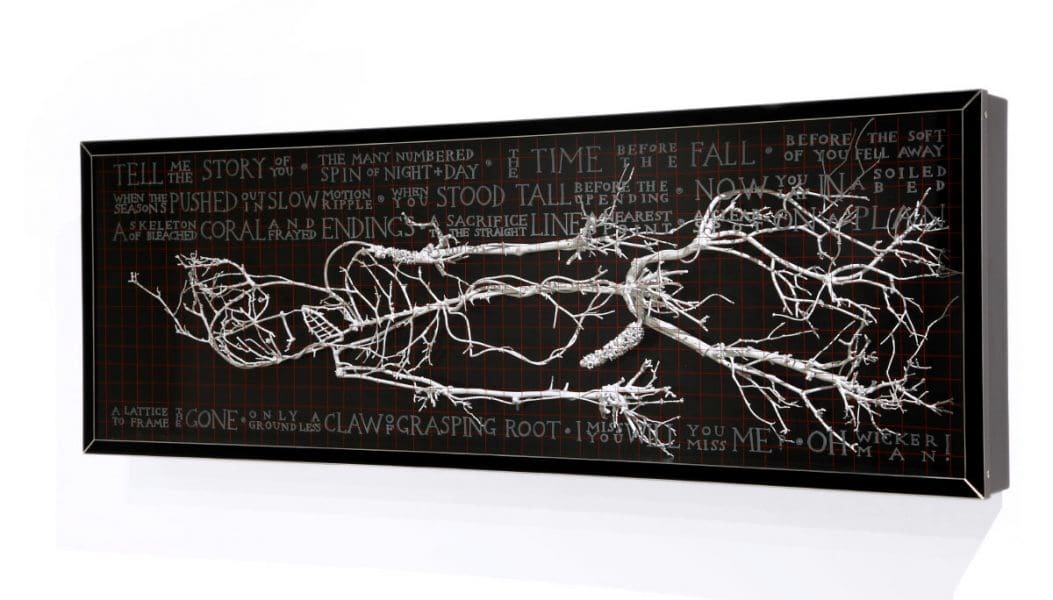
Patrick Hall, Felled, 2021, plywood, glass, acrylic paint, found organic material 36 x 96 x 9 cm.
Tasmanian artist Patrick Hall is known for creating intricately constructed cabinets that go far beyond function alone. Embellishing the surfaces of his finely crafted objects with collections of found ephemera, photographs and hand etched text, Hall’s cabinets have been likened to repositories of memory that weave together poetic narratives steeped in world history and personal experience.
Made of Broken Pieces contains a selection of Hall’s work created from 2019 onwards, and ranges across sculpture, collage and photography. With a background in furniture design and printmaking, much of Hall’s professional practice has revolved around sculptural and functional objects. However, in Fade Series, 2021 Hall has returned to working on paper. Using white paper as a sculptural material, in this collection of work Hall has manipulated his chosen material into texturally illustrative scenes by cutting, folding and tearing it into shape. Thin strips of paper folded into accordion pleats become the tracks of a military tank, and stacked up paper layers make up the silhouette of an urban horizon or a battleship. Describing these works as “an elegy to the World War II generation,” Hall also includes lines of hand cut text reflecting historical communication methods and personal memories of his father, a decorated war veteran.
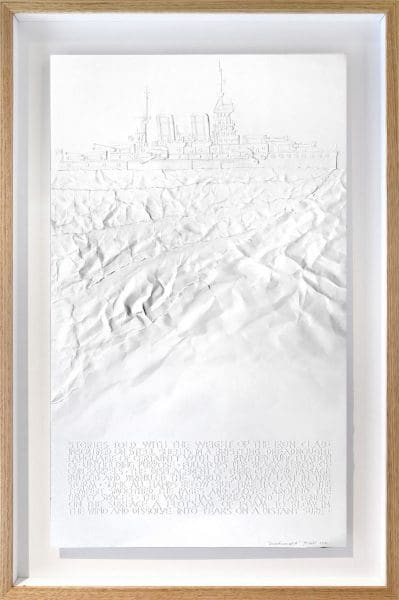
“I wanted to bring out the natural connection between paper and text in this series,” Hall explains. “I hand cut the lettering, so the words not only have their own meaning, they also become aesthetically part of the visual landscape. While the texts are atmospheric and layered in meaning, the images are rendered in a deliberately naive style reminiscent of an 8-year-old boy obsessed with war stories, the type of drawings you might find in the margins of a math schoolbook.”
Fade Series leans into the thematic foundation of another of Hall’s wall-mounted works, The Promised Land, 2021 which contains hundreds of passport size portrait photographs printed on tags and joined together by white string. Referencing the Jewish refugees traveling from Germany to Cuba aboard the St Louis liner in 1939, Hall has woven hundreds of strings vertically and horizontally across the frame to link the photos together, visually recalling how the passengers were refused entry to Cuba and sent back to Europe. As Hall puts it, “At this intersection, the crisscross weave of history is caught in the net of now. A string boundary forms between the peeling labels, lost luggage of old worlds and the shining future of promised lands.”

In addition to his new works on paper, Hall has also been working with mirrors—scratching text into their surfaces and imbuing them with patterns and images. Again, calling upon WWII military references, On My Father’s Side, 2021 contains circular patterns resembling puncture wounds or bullet holes. Gold text is engraved across the glass and at the centre of each circular form is a close-up photograph of a face. Aged photographic portraits also appear on the façade of Made of Broken Pieces, 2021, a tall, multi-drawer cabinet made from Tasmanian oak.
Summing up the underlying premise of his new work Hall says, “The lived experience of the WWII generation is fading. This is my small way of trying to pin down some of those memories. To put something down on paper is to fix it permanently in time but like memories themselves the material is fragile, and it can fade and fall apart. Even visceral and cataclysmic events can become myth or simply be forgotten. Through these recent works I’m trying to honour those people and that time.”
Patrick Hall
Made of Broken Pieces
Despard Gallery, Hobart
22 September—16 October